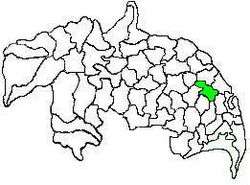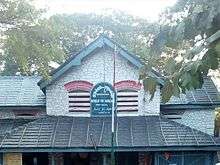Tenali mandal
Tenali mandal is one of the 57 mandals in Guntur district of the Indian state of Andhra Pradesh. It is under the administration of Tenali revenue division, headquartered at Tenali.[2]:650[3]:14 The mandal is located in Velanadu region,[4] bounded by Pedakakani, Duggirala, Kollipara, Vemuru, Amruthalur, Tsundur and Chebrole mandals.[2]
Tenali mandal | |
|---|---|
 Mandal map of Guntur district showing Tenali mandal (in green) | |
.svg.png) Tenali mandal Location in Andhra Pradesh, India | |
| Coordinates: 16°14′34″N 80°38′24″E | |
| Country | India |
| State | Andhra Pradesh |
| District | Guntur |
| Headquarters | Tenali |
| Government | |
| • Body | Mandal Parishad |
| • Tehsildar | G.V.Subba Reddy |
| Population (2011)[1] | |
| • Total | 240,031 |
| Languages | |
| • Official | Telugu |
| Time zone | UTC+5:30 (IST) |
History
Guntur district was constituted in the year 1904 and Tenali was one of the eight taluks of the district. On 1 July 1909, Tenali taluk was split into Tenali and Repalle taluks. In 1981–82, Tenali taluk was again split into Tenali and Emani taluks. Tenali city taluk was spiltted into Vemuru and Tenali Mandals. Later it was split it into Tenali and Bapatla mandals. On 25 May 1985, mandals were recognised, replacing taluks and firkas.[5]
Demographics
As of 2011 census, the mandal had a population of 240,031. The total population constituted 118,616 males and 121,415 females, for a sex ratio of 1024 females per 1000 males. 21,333 children were in the age group of 0–6 years, of which 10,939 were boys and 10,394 were girls. The average literacy rate stood at 79.89% with 174,711 literates.[1]
Devarapalleseri is the village with the smallest area of all the villages in the district, 11 ha (27 acres).[3]:17 Tenali is the most populated and Nelapadu is the least populated settlement in the mandal.[6]
Government
Administration

The mandal also forms a part of the Andhra Pradesh Capital Region under the jurisdiction of APCRDA.[7] It is under the control of a tahsildar; the present tahsildar is G.V. Subba Reddy.[8]
As of 2011 census, the mandal has thirteen villages with one town.[3]:46[2]:651
The settlements in the mandal are:
- Angalakuduru (merged in the city)
- Burripalem (merged in the city)
- Chinaravuru (merged in the city)
- Devarapalliseri
- Gudivada
- Katevaram (merged in the city)
- Kolakaluru
- Nandivelugu
- Nelapadu (merged in the city)
- Pedaravuru (merged in the city)
- Pinapadu (rural) (merged in the city)
- Sangam Jagarlamudi
- Tenali (M) (converted from town to city by expanding and merging the areas)
- Yerukalapudi
Note: M: municipality[9]
Politics
Tenali mandal is one of the two mandals under Tenali assembly constituency, which in turn represents Guntur lok sabha constituency of Andhra Pradesh.[10] It was under Tenali lok Sabha constituency until 2008.[11]
Education
The mandal plays a major role in education for the rural students of the nearby villages. The primary and secondary school education is imparted by government, aided and private schools, under the School Education Department of the state.[12] As per the school information report for the academic year 2015–16, the mandal had more than 32,571 students enrolled in over 204 schools.[13][14]
See also
- List of mandals in Andhra Pradesh
- Villages in Tenali mandal
References
- "Census 2011". The Registrar General & Census Commissioner, India. Retrieved 26 July 2014.
- "District Census Hand Book – Guntur (Part XII-A)" (PDF). Census of India. Registrar General and Census Commissioner of India. Retrieved 31 May 2019.
- "District Census Handbook – Guntur" (PDF). Census of India. Retrieved 20 February 2016.
- Talbot, Cynthia (20 September 2001). Precolonial India in Practice: Society, Region, and Identity in Medieval Andhra. Oxford University Press. ISBN 978-0-19-803123-9.
- "Hand Book of Statistics 2013 Guntur District" (PDF). pp. i. Retrieved 9 September 2016.
- "Sub-District Details of Guntur District". The Registrar General & Census Commissioner, India. Archived from the original on 15 April 2015. Retrieved 24 May 2014.
- "District wise mandals and villages covered in Krishna and Guntur districts" (PDF). Andhra Pradesh Capital Region Development Authority. Government of Andhra Pradesh. Archived from the original (PDF) on 23 September 2015. Retrieved 23 September 2015.
- "List of Tahsildars working in Guntur District as on 19.06.2014" (PDF). Guntur District Official Website. National Informatics Centre. p. 2. Retrieved 23 January 2015.
- "Abbreviations used". censusindia.gov.in. Retrieved 26 May 2014.
- "Delimitation of Parliamentary and Assembly Constituencies Order, 2008" (pdf). Election Commission of India. p. 22. Retrieved 11 October 2014.
- "All eyes on Guntur Lok Sabha seat". The Hindu. Guntur. 11 March 2009. Retrieved 16 October 2014.
- "School Education Department" (PDF). School Education Department, Government of Andhra Pradesh. Archived from the original (PDF) on 19 March 2016. Retrieved 7 November 2016.
- "R1.1 SCHOOL INFORMATION". Archived from the original on 8 November 2016.
- "Student Information Report". Commissionerate of School Education. Child info 2015–16, District School Education – Andhra Pradesh. Retrieved 8 November 2016.